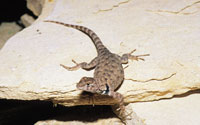A guide to swift and spiny lizards.
Of the many species of swifts and spiny lizards, 22 species, some with several subspecies, occur in the United States. Others are found southward through Mexico to northern Panama. In the United States, the lizards of this group are found from southern New York, southern South Dakota and northern Washington in the north, to South Florida, the Gulf States and the Mexican border. Several of the fence lizards (which, because of their rapid movements, are colloquially referred to as “swifts”) are familiar backyard species. Others, among them the bunchgrass lizards and Yarrow’s spiny lizard, are denizens of remote montane fastnesses.
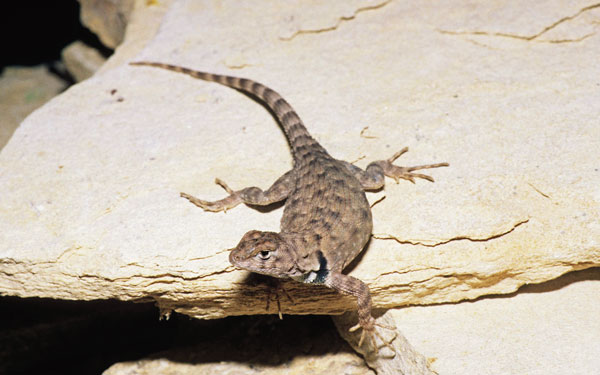
Big Bend Canyon lizard (S. m.annulatus)
If using a field guide written prior to 2005, you will note that some names in this article differ from those in your guide. This is because genetics, rather than appearance, are now used by most taxonomists to determine valid species, and there is a strong tendency by those same researchers to not recognize subspecies. As you may imagine, field researchers and lab researchers seldom agree. Studies are ongoing, and additional name changes will undoubtedly occur. Our two Field Guides — A Guide and Reference to the Crocodilians, Turtles, and Lizards of Eastern and Central North America (North of Mexico) and Guide and Reference to the Turtles and Lizards of Western North America (North of Mexico) and Hawaii, both published by the University Press of Florida — are the most up-to-date guides available and contain, in addition to descriptive text, colored photographs of all species and subspecies of swifts and spiny lizards.
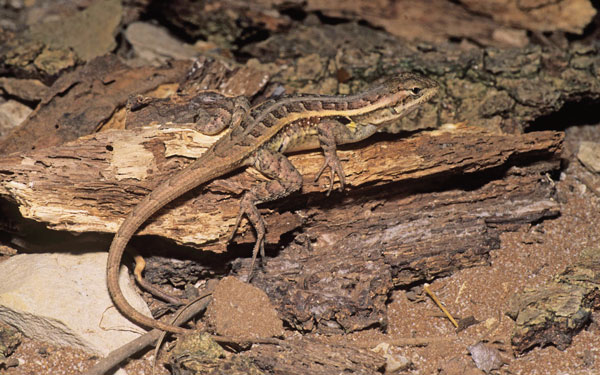
Rose bellied lizard. (S. variabilis marmoratus)
No matter large or small, juvenile or adult, all species in this group are quite similar. In external appearance, they are long-tailed, stocky lizards with a head of moderate size. All are capable of modest color changes. They are darkest when cold, inactive or beginning the day’s basking, and lightest when optimum body temperature has been attained and the lizards are alert and foraging. The spiny lizards of the United States are clad dorsally in scales of rock gray or tree-bark brown, and they may be striped, marked with rearward directed chevrons, or both. They are of lighter coloration ventrally, and males of most have blue ventrolateral patches and a blue and black throat that is displayed to females and during territorial advertisements in a series of stylized pushups. Rather than blue, the aptly named rose-bellied lizard of Texas, Mexico and Central America, has rosy belly patches.
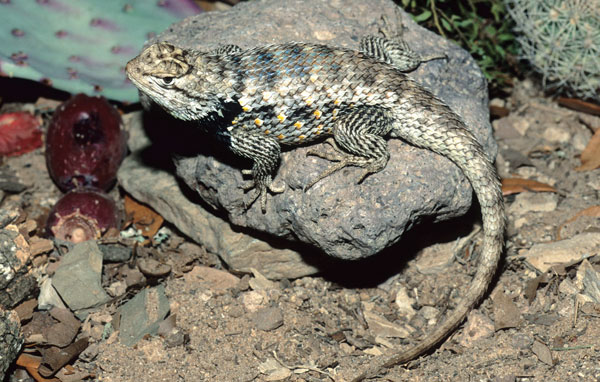
Twin spotted lizard (S. bimaculatus)
The Pet Market
Despite being found in many (if not most) regions of the United States, very few of the Sceloporus (often referred to as “scelops” for short) are routinely available at reptile dealers and pet stores. In fact, some of the more common and wide-ranging species, none of which are particularly showy, are virtually unknown in the American pet trade.
Except for the species that occur in the United States, only the beautiful variably green emerald swift (Sceloporus malachiticus) of Central America is commonly available to American hobbyists. This high-elevation, cloud-forest dwelling, live-bearing species can be difficult to acclimate and is not a beginner’s lizard. They are tempting because of their beauty and the fact they are rather inexpensive. Even when they are heavy-bodied and feeding eagerly as fresh imports, they have a tendency to become emaciated, a condition that, once started, is difficult to stabilize or reverse. It is difficult to duplicate the high-altitude environment in which this species has evolved.
Many hobbyist keepers collect their own swifts and spiny lizards from the wild. Before doing this, I strongly urge you to familiarize yourself with the laws in your home state and of all states in which you intend to collect lizards. Running afoul of non-game laws and regulations is not something to be taken lightly, and the penalties can become even more severe if a lizard collected in violation of existing laws is transported across state lines.
Sceloporus Enclosure Size and Design
Caging for these lizards is not merely a matter of securing one in an escape-proof cage or terrarium and placing it on a shelf. Enclosure design, humidity, lighting, heating, feeding and watering must all be considered.
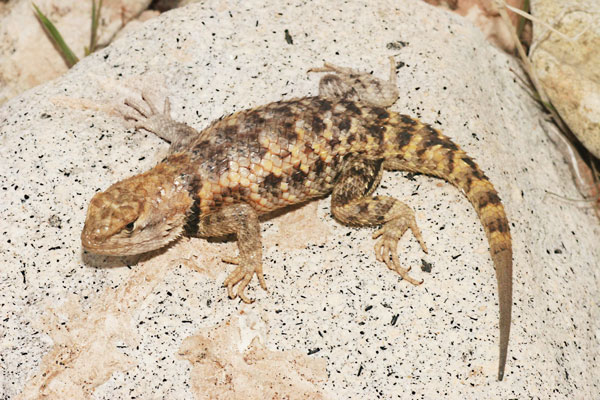
Yellow back spiny lizard (S. uniformis)
The size and interior design of the cage needed for your spiny lizards should be determined by the adult size and species you have decided to maintain. Swifts and spiny lizards need space. All spiny lizards are active heliotherms (basking lizards) that, in the wild, move quickly between sun-splashed boulders or into arboreal positions to avail themselves of optimum temperatures and prey availability. Although as a group these lizards are often referred to as arboreal, this term is not always accurate. Some, such as the eastern fence lizards, do climb trees, and the mesquite lizard is persistently arboreal. Others, such as the large granite spiny lizard are rock dwellers (saxicolous) and are agile, wary and well-camouflaged. In good caging, the lizards may be hard to spot even when in plain sight. The sagebrush, scrub and prairie lizards will be most comfortable on rocks, limbs or similar cage furnishings. Terraria or cages meeting these criteria will require concerted effort on your part. This is your obligation as a keeper.
Please do remember that having a sturdy stand is as important as designing the optimal terrarium. Cages and aquaria can be heavy by themselves, but the addition of the cage substrate and furniture will add significantly to the overall weight.
A pair or trio of any of the small species can be set up in a 15- to 20-gallon or larger capacity terrarium with the right furnishings. A sandy or pebbly substrate, real or artificial horizontal or diagonal limbs of two times the body diameter of the lizards or greater, and an easily accessible water dish should be the predominant theme for all species enclosures.
When housing the saxicolous (rock specialist) species, reducing the number of limbs and adding sloping or flat pieces of shale or other flat rock elevated to a proper basking height will make your lizards feel more at home. Be certain the rocks are securely placed; your lizards will spend some time hiding in rock crevices.
Meet the spiny lizards, genus Sceloporus, of the United States.
The small species include sagebrush, canyon, fence, prairie and bunchgrass lizards.
Dunes sagebrush lizard (S. arenicolus): Texas and N.M.
Northern sagebrush lizard (S. graciosus graciosus): N.D., Wyo., Idaho, Wash., Ore., Calif., Nev., Utah, Ariz., N.M., Colo., Mont., and Neb.
Western sagebrush lizard (S. g. gracilis): Ore., and Calif.
Southern sagebrush lizard (S. g. vandenburgianus): Calif.
Prairie lizard (S. consobrinus): Texas, N.M., Ariz., Okla., Colo., Kan., Neb., and S.D.
Southwestern fence lizard (S. cowlesi): N.M., and Ariz.
Mesquite lizard (S. grammicus microlepidotus): Texas.
Yarrow’s spiny lizard (S. jarrovi): N.M., and Ariz.
Merriam’s Canyon lizard (S. merriami merriami): Texas.
Big Bend Canyon lizard (S. m.annulatus): Texas.
Presidio Canyon lizard (S. m. longipunctatus): Texas.
Northwestern fence lizard (S. occidentalis occidentalis,):Calif., Ore., and Wash.
Island fence lizard (S. o. becki): Calif.
San Joaquin fence lizard (S. o. biseriatus): Calif.
Coast Range fence lizard (S. o. bocourti): Calif.
Great Basin fence lizard (S. o. longipes): Calif., Idaho, Ore., Nev., Utah, and Wash.
Sierra fence lizard (S. o. taylori): Calif.
Slevin’s bunchgrass lizard (S. slevini):N.M., and Ariz.
Plateau fence lizard (S. tristichus): Ariz., N.M., Nev., Utah, Colo., and WY
Eastern fence lizard (S. undulates): N.Y., N.J., Pa., Ohio, Ind., Ill., Mo., Kan., Okla., Texas, La., Ark., Ky., W. Va., Va., N.C., S.C., Ga., Fla., Ala., Miss., and Tenn.
Texas rose-bellied lizard (S. variabilis marmoratus): Texas.
Striped plateau lizard (S. virgatus): N.M., and Ariz.
Florida scrub lizard (S. woodi): Fla.
Included in the larger species are the desert, blue, Clark’s and crevice spiny lizards.
Twin-spotted spiny lizard (S. bimaculatus): Texas, N.M., and Ariz.
Sonoran spiny lizard (S. clarkii clarkia): N.M., and Ariz.
Plateau spiny lizard (S. c. villaris): Ariz.
Blue spiny lizard (S. cyanogenys): Texas.
New Mexico crevice spiny lizard (S. poinsettii poinsettia): Texas and N.M.
Texas crevice spiny lizard (S. p. axtelli): Texas and N.M.
Desert spiny lizard (S.magister): Ariz.
Texas spiny lizard (S. olivaceus): Texas.
Granite spiny lizard (S. orcutti): Calif.
Yellow-backed spiny lizard (S. uniformis): Ariz., Calif., Nev., Utah, Colo., and N.M.
When keeping the larger species of spiny lizard (desert or crevice spiny lizard), the terrarium décor can remain the same, but the terrarium/cage size should be increased. A 30-gallon capacity cage will house a pair of blue or desert spiny lizards, and a 50-gallon terrarium will be adequate for a trio. Of course, as with the smaller species, the larger the cage, the better. In the wild, these lizards inhabit territories at least as large as a human bedroom.
Heating and Lighting for Spiny Lizards
At this outset, let’s mention some suggested parameters of terrarium/caging lighting and heating. All species contained in the genus Sceloporus, the swifts and spiny lizards, are diurnal and heliothermic. That is, they are active by day and are basking lizards. Northern and high-elevation species brumate (the reptilian equivalent of hibernation) throughout the months of winter. Species in the deep south remain active throughout much of the year, remaining hidden and inactive during rainy, overcast weather or during the passage of cold frontal systems.
Although you can keep your swifts and spiny lizards active year-round by maintaining a suitable regimen of heat and lighting, it may not be possible to cycle those species that are normally inactive in winter without providing them with several months of cooling during the winter months. If you do decide to brumate your scelops, full darkness and a temperature in the high 40s or low 50s (degrees Fahrenheit) should be maintained. The hibernating chamber should provide a moderate humidity of 60 to 70 percent, but no actual wetness.
Unless physically impeded, the beneficial output of natural (full-spectrum) sunlight is relatively stable. No matter at what point in its habitat a lizard chooses to bask — high in a tree or on a ground-level rock — the benefits (UVA, UVB and warmth) will be nearly the same. The beneficial aspects of full-spectrum cage lighting, however, are a different prospect entirely, and one that must be carefully considered during enclosure construction. Even the best of the full-spectrum bulbs produce only small amounts of the desired ultraviolet rays, and these are effective for only a short distance. In most cases, the basking spot for your lizard must be 12 inches or less from the bulb. Follow the instructions provided with your bulbs carefully. The best full-spectrum bulb produced will do no good and can be harmful if positioned improperly. Remember that your lizard must always be able to move to a cooler area of its cage and get away from the light. Full-spectrum lighting is now offered in both fluorescent and incandescent styles. While the fluorescent provides only lighting, the incandescent format can provide both light and heat.
Whether in the wild or in captivity, swifts and spiny lizards will warm themselves in one or both of two ways. Arboreal species will simply splay out on a heated or sunny limb or trunk. If the latter, the lizard will often follow the sunny patches as they move, until the lizards are warmed. Saxicolous species not only utilize sunny rocks, but also elevate their body temperatures more quickly by lying flat against a rock surface already preheated by the sun (or a heat lamp).
Of course, unlike the ever-moving sun, cage lighting is usually stationary. It will be necessary for you to position the full-spectrum lighting and the heat where it will best serve the needs of your lizard. Lighting should be available for at least 12 hours a day, and I have had best results when my lighting simulates the normal, seasonally variable photoperiod. A brilliantly lit and sufficiently warmed cage will stimulate these diurnal sun-loving lizards to indulge in normal activity, including feeding, territoriality and breeding. A cage that is insufficiently lighted or too cool will result in lethargic lizards that fail to thrive. Conversely, a cage that is too warm overall will cause the swifts and spiny lizards to burrow or seek other shelter to gain relief, again failing to thrive. Spiny lizards will do well if, in addition to sufficient lighting, the cage is maintained at 80 to 82 degrees with a basking spot of 100 to 108 degrees. Take particular care to have the basking area you provide well within the parameters suggested for the bulb you choose. With the bulb off at night, cage temperatures may be allowed to drop to normal room temperatures (70 to 78 degrees).
Feeding Sceloporus Lizards
Scelops are insectivorous lizards, but not all species or individuals will eat all types of insects readily, so you should experiment. Giant mealworms (Zophobas), regular mealworms (Tenebrio), waxworms (Galleria), crickets (Acheta), silkworms (Bombyx) and other non-noxious caterpillars, and various small roaches of several genera, are all commercially available and excellent food items. If you have nearby fields or meadows that have not been subjected to insecticides, “field plankton,” insects collected with a sweepnet, can be collected during the warm months as a dietary additive. A diet consisting of varied insect species is better for the lizards than a diet of only one or two insect species.
Also of importance is to choose insects of the proper size. All offered insects should be relatively small when compared to the lizard’s head. Select insects with relatively soft bodies, such as subadult crickets and mealworms, that can be easily chewed and are no more than one-third the width of the lizard’s jaws. Even if ample full-spectrum lighting is provided, your feeder insects (with the exception of freshly collected insects from the field) should be dusted periodically with a vitamin D3 calcium powder. Suggested intervals for the dusting would be every 10 days to two weeks for adult lizards and weekly for growing lizards. Scelops will usually stop eating when they are sufficiently filled, but if you find your lizard is becoming obese, cut back on the amount of food offered.
Compatibility and Breeding of Swift and Spiny Lizards
Both sexes of all swifts and spiny lizards are alert and territorial. Males of the same species and of closely allied species and subspecies are especially quarrelsome and are particularly prone to skirmishes with each other when they are reproductively active. Unless you have an immense cage containing many visual barriers, it is best to keep only a single pair (or perhaps a trio of one male and two females) to an enclosure.
As mentioned earlier, most species in this lizard genus are easily sexed. Males of most have blue belly and throat patches (rose on one species) of varying intensities and sizes. These flash colors are lacking or greatly reduced on most females. Additionally, males have a thickened tail base and enlarged femoral pores on the underside of each hind limb. All of these characteristics are most enhanced when the lizards are reproductively active.
Breeding activities begin in the spring and continue periodically while the photoperiod is lengthening. With most species, activities decline with the declining hours of daylight. Mesquite lizards, blue spiny lizards, crevice spiny lizards and Yarrow’s spiny lizards give birth to a single clutch of live young annually. All other species of the United States are egg layers. REPTILES
Dick Bartlett is a herpetologist/herpetoculturist who has written hundreds of articles and many books, some with his wife, Patti. He has bred 175 captive herp species. A frequent lecturer, he has participated in field studies in North and Latin America, and he has led tours to the Peruvian Amazon.

